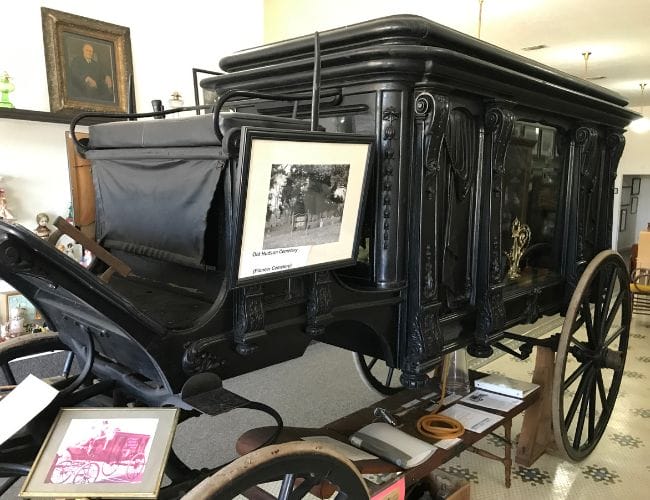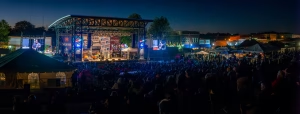

Uh oh...
It appears that you're using a severely outdated version of Safari on Windows. Many features won't work correctly, and functionality can't be guaranteed. Please try viewing this website in Edge, Mozilla, Chrome, or another modern browser. Sorry for any inconvenience this may have caused!
Read More about this safari issue.

So many towns in Arkansas have sacred stories to tell: tales of notoriety, perseverance, heroism, luck and charm. For my family, some of the greatest stories of the discovery of Arkansas history have come through visiting museums across south Arkansas. These stories have unfolded the development of small townships and tell the journey of building communities out of local opportunities and special locations.
This fall, can you take on the challenge to get out and discover local stories? Learn how your community was established. Who were the founders? What drew them to that region? What industry originally helped your town boom, and is that still driving your local economy?
Once you have your local stories covered, take time to do a little traveling and discover these 16 must-visit museums in south Arkansas.

1. Two Rivers Museum | Ashdown
Volunteers operate the museum on special days throughout the week and will personally escort you through the displays. They share stories of early settlers establishing community, a railroad era, famous physicians, teachers and athletes who gained notoriety. They tell about novelty home pieces. The mural on the side of the building is not only a landmark to the location but a hot spot for selfies and tourist photos.
Special feature: The lobby of the museum hosts a Civil War-era hearse used locally throughout the county. The hearse functions using a peg system, an early form of technology to hold the coffin in place on bumpy rural roads.
2. McCollum Chidester House | Camden
The McCollum Chidester House was the first planned lumber home in Ouachita County, and possibly south Arkansas. Made with materials sent from New Orleans, the house has remained a landmark of architecture and domestic building techniques. John Chidester, the second owner, was seeking to expand his stagecoach line and mail route and established the opulence of the home. During the Union Troop’s stay in Camden, Chidester was accused of being a spy and sent to Texas until after the war.
Special feature: Visitors can view Mrs. Chidester’s original china dishes and many of the first belongings she and her husband brought to the home in the 1860s.

3. Hoo-Hoo Headquarters | Gurdon
The official world headquarters of the timber industry is everything its name indicates: whimsical, authoritative and mysterious. The legend goes that due to weather, a handful of timbermen, gathered in Gurdon for an industry meeting, were delayed waiting on a train, had a little too much to drink and dreamed up an organization that could meet in this spot annually and commemorate the occasion in less “stuffy” and more “humorous” gatherings.
Special feature: The official mascot of the Concatenated Order of the Hoo-Hoo is a black cat with a specifically swirled tail. Several examples of the mascot are exhibited throughout the museum as well as memorabilia of their leader “the Grand Snark.”

4. Arkansas Museum of Natural Resources | Smackover
This Arkansas State Park museum tells the story of the South Arkansas oil boom and the tent city that formed and established Smackover as more than a drive-through town on a map. At one point it was said that the greatest group of oil millionaires were doing business in Smackover: Arkansas’s own Silicon Valley. The museum is a sensory experience in every way and tells the story of the discovery of oil and how the county continues to play a vital role in the petroleum industry today.
Special feature: Toward the end of the self-guided tour is an established Tinkering Studio that allows children (and their grown-ups) to play and create with products related to petroleum. A kid-sized interactive display teaches about the consumables in our everyday life.
5. World War II Japanese — American Internment Museum | McGhee
This museum, in the former Missouri Pacific Railroad Depot, shares the history of Japanese-American internment during World War II. It also includes access to tour the Rohwer War Relocation Center where more than 8,000 Japanese-Americans were detained. It is a hard history to unfold, but the Arkansas State Heritage Sites’ team has molded together a depiction that tells the story many do not know.
Special feature: George Takei, famed “Star Trek” actor and former resident at Rohwer, was part of the dedication ceremonies in 2013. He recorded many of the audio stories shared through visual panels at the memorial site.
6. Mena Train Depot (Kansas City Southern Railroad Museum) | Mena
The train depot in Polk County is full of tour information for historical homes, a Lum and Abner exhibit, and stories of Queen Wilhemina and Janssen who founded Polk County. It is along the main Kansas City Southern Rail line, and if you hit it just right, you can experience the train while you are touring the station that was a cornerstone of establishing the railroad from St. Louis to south Texas.
Special Feature: In the back of the depot is a display of photographs of the rails in Polk County during different seasons and “A Ouachita Portrait,” a Prismacolor collection of drawings by Monta Black Philpot.

7. Sevier County Historical Museum
Moving south from Mena, the train and its developer, Arthur Stillwell, set a route that reestablished the economic development of Sevier County to a more central location in De Queen, Arkansas. The museum, located not far from the original Fort Townsend line, makes this destination part of the third arm of the Trail of Tears.
Special feature: A miniature founders’ village is accessible when the museum is open. The area also includes a conductor’s train car and is a perfect tour for children or grown-ups who love trains.
8. Ashley County Museum and Watson House | Hamburg
The grand Greek Revival home of David E. Watson is the reason to visit. While it houses the Ashley County Historical Society, the 1918 Neo-Classical Revival style is highly reminiscent of architectural structures of the time period, and many of the original decorative features remain, including eight large columns on the front of the home. A 2010 renovation gutted the kitchen and made the venue, mostly used as a location for showers, weddings and philanthropic events more friendly for catering.
Special feature: The front parlor of the home hosts a grand piano made in the 1860s that arrived in Ashley County by wagon in 1890.
9. Nevada County Depot and Museum | Prescott
The arrival of the train established many smaller south Arkansas communities and proved a great success for connecting local farms with a greater audience for goods and disbursement.
Special feature: The display includes many military artifacts from both World Wars and the Arkansas National Guard. Also included: memorabilia from the Battle of Elkin’s Ferry and Prairie D’Ane, both Civil War conflicts near Prescott.
10. Train Depot Museum | Hope
This train depot is a sacred space for many because it includes memorabilia from Bill Clinton and Mike Huckabee in their eras of growing up and political campaigns that launched from this small town.
Special feature: Most people come for the high school and childhood memorabilia pieces of Clinton and Huckabee. But still a well-known and active passenger stop for the Amtrak line, the depot showcases much about the ticketing and riding experience over the years and pays homage to the past passenger trains of this community.

11. Howard County Historical Society and 1912 EA Williams Chapel Museum | Nashville
Located inside the 1912 Presbyterian Church, the unique setting of the historical museum is not bordered along walls and displays in a backroom, rather it lines the walls of the wooden church building and celebrates the settlement of an important community.
Special feature: A new addition is a train house for the model set that can now be moved and relocated to community events and children’s programs, bringing greater access to the story of the museum.
12. Dallas County Museum | Fordyce
Tells the story of the county and the famous Sparkman Sparklers. But the real gem is the information about Paul “Bear” Bryant who grew up in this area. The Dallas County Sports Museum recently hosted a traveling Smithsonian exhibit and tells the story of many famous Arkansans who first tied their sneakers in Dallas County.
Special feature: The telephone room exposes those interested in media with early communication tools and demonstrations.

13. Klipsch Museum of Audio History | Hope
This rare find is part of a pilgrimage tour that many people only get one chance to visit. The museum is a collection of early speaker and audio technology tools that honor the field of communication and the role that Paul W. Klipsch played in establishing early high fidelity and high definition resources.
Special feature: The museum’s building is the “largest artifact.” It was the site of the first Klipsch Manufacturing plant.

14. Lakeport Plantation | Lake Village
This plantation home, built on the Mississippi is a gem of the Arkansas Delta. The stories of the Johnson family’s sharecropping, daily living, and family life are told throughout the museum and home tour. It is the only surviving Arkansas plantation home on the Mississippi River.
Special feature: The land has remained in continual cotton production since 1830 and provides live documentation of the south Arkansas agricultural environment.

15. Mid-America Science Museum | Hot Springs
This fully hands-on science museum is a hidden treasure on the western boundary of the Hot Springs National Park. It’s hard to list one special feature, but exhibits include: a DinoTrek, the Skywalk and Light Bridge, a Tesla coil that emits 1.5 million volts of electricity and the Kye-Yac Clubhouse focused exclusively on early childhood learning and interaction.

16. Gangster Museum | Hot Springs
The Gangster Museum shares the stories of the 1940s. Long before Las Vegas was famous for shenanigans, Grand Avenue in Hot Springs kicked things off with rivalries greater than any SEC game weekend.
Special feature: An extra exhibit hall hosts roving collections, and the current exhibit shares the stories of a sacred baseball era in Hot Springs when Babe Ruth, Dizzy Dean, Daffy Dean and Hank Aaron spent more than just their summers stretching and preparing for the next season.

If you are looking for other ways to celebrate and explore Arkansas this fall, check out some of these options:
Join the Conversation
Leave a Comment
4 responses to “16 South Arkansas Museums to Visit this Fall”
 Leave a Reply
Leave a Reply
We do the work.
You check your email.
Sign up for our weekly e-news.
Get stories sent straight to your inbox!












 Leave a Reply
Leave a Reply
[…] 16 South Arkansas Museums to Visit this Fall by Keisha Pittman McKinney […]
[…] The McCollum-Chidester Museum, a must-visit experience in south Arkansas, stands at the corridor on the edge of town beginning the historic Washington Street District. Ouachita County Historical Society operates the museum, which serves as a signature for the southern part of the state. […]
[…] histories of many towns in south Arkansas are preserved through small museums. Over time, as stories began to unfold with the gathering of family heirlooms and attic treasures, […]
[…] Bay Log Cabin Museum Crystal Bridges Museum Interactive Science Museums 16 South Arkansas Museums The Museum of the Arkansas Grand Prairie Clark County Historical Museum Blythe’s Scott County […]